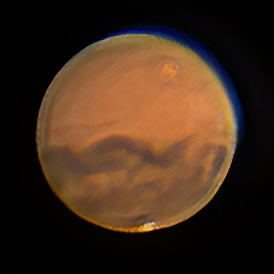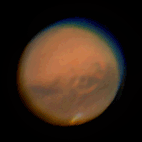In mid-October 2020, Mars was was at "opposition" – its closest approach to Earth. Mars, Earth and the Sun form a straight line, with Earth in the middle. This alignment makes Mars bigger and brighter, and offers a great opportunity to image the planet. I was eager to take advantage of this because next opposition won't occur until 2035.
I normally use my telescope and camera for deep-space imaging, but Mars requires higher magnification and a camera with smaller pixels. I purchased a Tele Vue 2.5X Powermate and ZWO ASI-178MC planetary camera to meet these needs, and installed them in place of my regular camera.
Because planetary imaging is different than deep-space imaging, I'm learning a new technique called "lucky imaging" explained below. This is an early image, and I hope for better results when I learn more and when the seeing is better.
North is up in this image. The round structure toward the northeast is Olympus Mons, a large shield volcano over 13 miles high.

The time-lapse animation below shows Mars' rotation over three hours. It contains the final processed images from all 24 imaging runs.

| Exposure |
• Lucky imaging (see below) • 24 30-second video imaging runs, spaced 7½ minutes apart • 1,100 frames of 2,238 (49%) from the best video file ☞ Exposure: 6½ milliseconds ☞ Frame rate: 75 frames per second |
| Processing |
• Images acquired with FireCapture • Image alignment and stacking with AutoStakkert! • Wavelet sharpening in RegiStax 6 • Final tweaking in Photoshop CS6 |
| Date and Location |
• October 21, 2020 • Louisa County, Virginia, USA |
|
Equipment |
• TMB-130SS APO refractor @ f/7 on an Astro-Physics 1200 mount • Tele Vue 2.5X Powermate yielding a focal ratio of f/17.5 • ZWO ASI-178MC one-shot color planetary camera |
Updated May 23, 2023